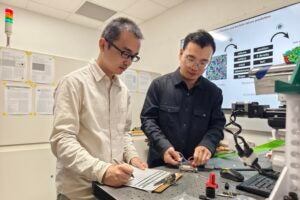One man’s trash really can be another’s treasure.
In an exhibit at the Visual Arts Center, crumpled, empty juice boxes, sticks, a glass jar that once held kombucha and a deflated basketball are transformed by strips of colorful, handmade batik and thick coats of bright paint into a contemplative work of art.
The group of detritus, is part of “Womanscape: Race, Gender and Sexuality in African Art,” an exhibit of contemporary paintings, photography, video and found art by or about African women, curated by Associate Professor Moyo Okediji.
The empty jugs, cartons, containers and twigs in African culture are considered male objects, said Okediji (pronounced OK-DG). In many African cultures, the concept of maleness is nude, an extrovert, dangerous and wasteful; while femaleness is covered, introverted, productive, nurturing and something unfathomable.
The found objects were transformed from male objects to female when the artist covered them with fabric and paint.
To illustrate, Okediji told a story about the artist Wole Lagunju. Lagunju was visiting with Okediji in Denver and was shocked by the amount of trash the two produced. In Africa, one would never get rid of an empty glass bottle because glass bottles are taken and filled with beer.

The day Okediji threw out his large scanner that couldn’t be fixed, his artist friend vowed that he was not going to throw containers away anymore. So he started saving them and covered the various empty, deflated, crushed containers with fabric made by African women.
“What the artist did is transform male forms into female forms,” said Okediji. “The empty containers represent something that has lost its energy and has become waste they are naked, nude, exposed by wrapping them in the batik and by painting over them, the artist covered these objects and made them into something female, something covered, something introverted, mysterious, vast and bottomless. He made them into contemplative objects.”
Okediji is a tall, bald man with a white beard. He is Nigerian, born in Lagos, and someone most Americans would identify as a black African male. But in Africa, he said people would say he is white.
“Because I have a Western education and what some people there consider a light complexion,” he said with a laugh. “The concept of whiteness is not a racial concept but a cultural concept that has much more to do with ethnicity.”
Part of the focus of “Womanscape” is to debunk the myth that all Africans are black. One of the large photographs in the exhibition is of a white African woman from Algeria sitting on a bed wearing a painted mask.
Ethnic identity in Africa is much more fluid than in America, and gender is localized, Okediji said. How one walks and talks has a lot to do with how one is perceived ethnically. Also, children are born gender neutral and the people immediately around them decide whether the child will be male or female. There are also rituals one can go through to become female, which is something Okediji himself experienced.
“If you are fortunate enough that these females decide that you can be one of them, they will take you through the process of becoming female,” he said.
The transformation from male to female is a reoccurring theme in the “Womanscape” contemporary art exhibition. The mask the Algerian woman wears in the photo is an oval canvas painted by Okediji working under his female name, Orisagbemi Arigbabuwo.
“Womanscape” is also a response to the current, de-stabilized socio-cultural situation in Africa, Okediji said. The equality of power distributed between males and females in Africa is something that traditionally existed, but that has been imposed upon by colonial and neo-colonial systems that have caused instability.

Okediji recalled a time when he would see women at the market singing, dancing, and even drinking in the streets every weekend. “Now, you never see that,” he said. “Their behavior was called sinful, and men started to create boundaries for women where boundaries never existed.”
African women are traditionally symbolized in African art by the bird, which is the only animal that can walk, swim and fly. In Africa, women transverse worlds and are considered divinities because of their ability to procreate. They leave this world to go to another world to get their child and bring that child back. The idea of total mobility defines the female.
But now, Okediji said, “You have a situation in post-colonial Africa where women are not sent to school,” and “their skills and opportunities are hindered. We need to find ways of mending things in such a way that women are given the power they need to function effectively in society.”
Over the course of years, Okediji has collected artwork by female African artists and helped them produce work. He traveled back and forth from Africa to the United States, bringing canvases to female artists across African to be painted.
“Art work belongs to humanity. It belongs to all of us,” said Okediji. “Meanings attached to art objects change as they cross frontiers. The power of the object lies in its adaptability to ever-changing contexts.”
The University of Rochester Press will release Okediji’s most recent book on African Art, “Western Frontiers of African Art” in the next three to four months. The book will be part of a trilogy that explores what happens when an art object is at the frontier, between indigenous culture and the global community.
The 12 artists represented in this exhibition include:
Tinuomi Afilaka, Subulade Agbe, Egbeyemi Akingbade, Oni Omoleye, Omilabu Olokose, Tinuade Arayemi, Akinyi Wadende, Zanele Muholi, Folasayo Dele-Ogunrinde, Orisagbemi Arigbabuwo, Tola Wewe, and Wole Lagunju.
Their works can be found in the VAC’s East Gallery in the Art and Art History building until March 12. Admission is free and open to the public.



